Everyday we think about what we’re going to do. Our brains are busy deciding how to spend our day, what to eat, what to wear, what to say, and so on and so on. Every part of our lives is played out in our minds in order to produce actions throughout the day.
Canadian Speaker and best selling author, Robin Sharma said,
“Everything is created twice. First in the mind, then in reality.”
To make our actions even more focused and intentional, using Visualization and Mental Rehearsal Techniques can help direct our thoughts toward better outcomes. Athletes are just one group of people who use these practices to further enhance their strength, skills, and prepare themselves to perform at peak levels, with consistent and measurable results.
But what is Mental Rehearsal Visualization? And how does it work?
Enhancing Performance Through Visualization
Mental Rehearsal is basically picturing yourself going through a routine. But there’s more to it than that. Mental Rehearsal is a specific type of visualization. Using mental rehearsal techniques to practice a skill or prepare for a particular task or event can include a combination of senses, including sight, hearing, feeling, and even physical movements.
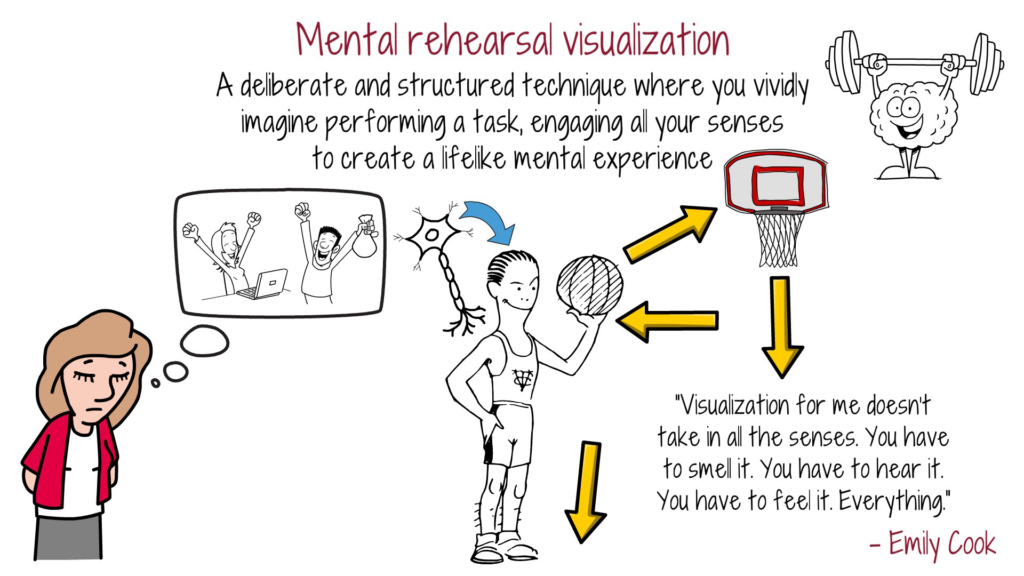
For example, a basketball player might picture themselves making free throws on the court. They could see the ball, the hoop, and feel their hands on the ball. Then visualize throwing the ball toward the hoop and hearing it swoosh easily through the net.
Combining more than just imagery makes a big difference with Mental Rehearsal techniques. American Olympic Aerialist, Emily Cook stated,
“Visualization for me doesn’t take in all the senses. You have to smell it. You have to hear it. You have to feel it. Everything.”
When you visualize with all of your senses in great detail, your brain responds as if it’s happening in physical reality. The same regions of the brain and neural pathways are activated as if they are experiencing the actual event. When it’s recorded in your memory it’s easier to repeat it again in the same way.
Mental Rehearsal Visualization techniques can increase confidence, focus, and readiness for whatever you are preparing for.
Who’s Using It?
This training technique is used by world-class athletes, as well as medical and military professionals, dancers, musicians, students, and more! The U.S. Navy flight squadron known as the Blue Angels use mental rehearsals in training for their shows. Football superstar, Tom Brady, used it to improve his performance on the field. He stated,
“Visualization is a crucial part of my preparation. I see myself executing the perfect plays and leading my team to victory.”
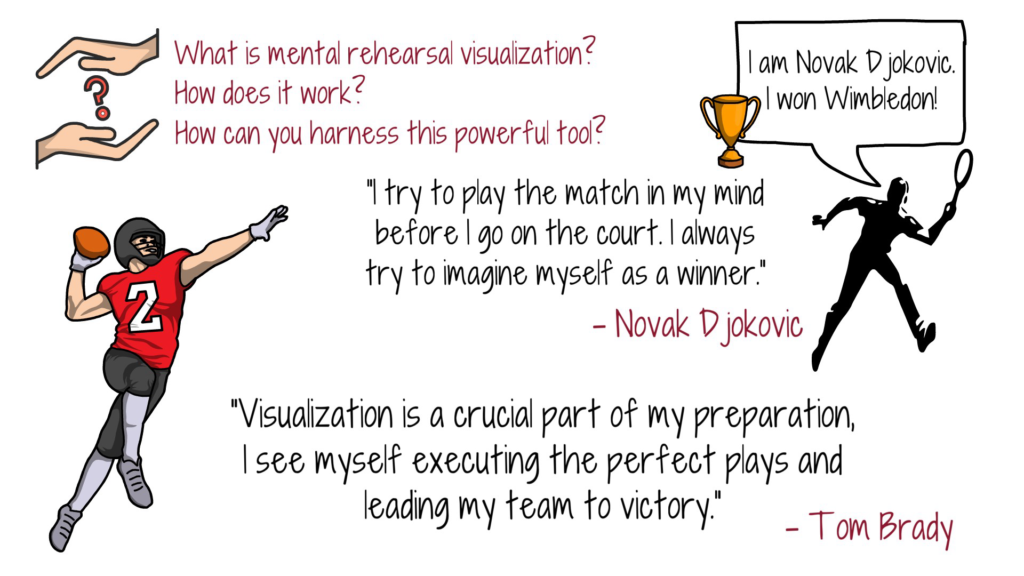
Tennis Champion, Novak Djokovic, was taught to use imagery at the age of 12. Part of his training involved listening to classical music while he practiced his skills. Recalling the music during a difficult match helped him to feel stronger and more confident. Another visualization technique he used in training was to hold a small trophy and declare, “I am Novak Djokovic. I won Wimbledon!”
After winning the championship, he talked about his visualization, “I try to play the match in my mind before I go on the court. I always try to imagine myself as a winner. I think there is a power to that.”
Challenges and Difficult Situations
Mental Rehearsal can be helpful in building skills and perfecting technique to achieve a goal. But it can also be used to troubleshoot problems that could occur. When you imagine what could go wrong, you can prepare for it.
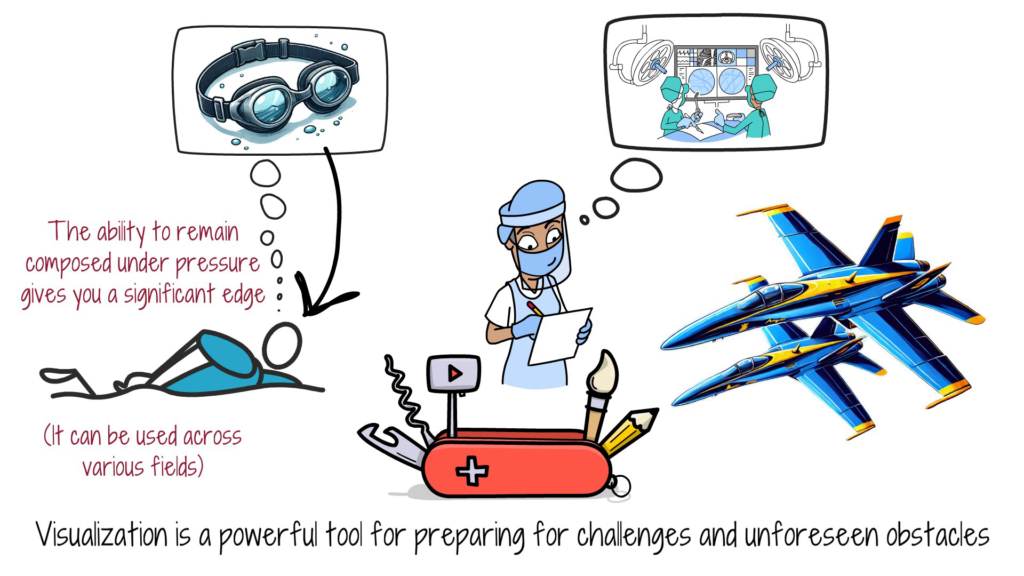
Olympic swimmer Michael Phelps said,
“I would visualize the best and worst case scenarios. Whether I get disqualified or my goggles fill up with water or I lose my goggles or I come in last. I’m ready for anything.”
This training served him well when in one competition he actually did have his goggles leak and fill up with water, but he was able to continue because he had prepared himself for such an event.
Dealing with anxiety and stress can also be helped by practicing Mental Rehearsal. For example, if you are planning to make a speech and are worried about it, you can rehearse the scenario in your mind in advance. Imagine all the details, like the sound and faces in the audience, the smell of the venue, and the feel of the podium under your fingertips. Visualize the nodding approval of the people listening to you. See yourself speaking flawlessly, and hear the applause at the end.
Other times, you might think of what could go wrong and how you might fix it quickly to get back on track. By playing out all the possibilities in your mind ahead of time in vivid detail, you can be prepared for whatever comes up. Stay positive in all of your scenarios, and always have the end result in your favor.
By being prepared for whatever happens, you can gain confidence and feel calm, even under adverse conditions because you’ve already experienced it.
Recovery and Rehabilitation
Mental Rehearsal and visualization techniques are also useful for recovery from an illness or injury. Some studies have shown that mental imagery can affect neurophysiological changes.
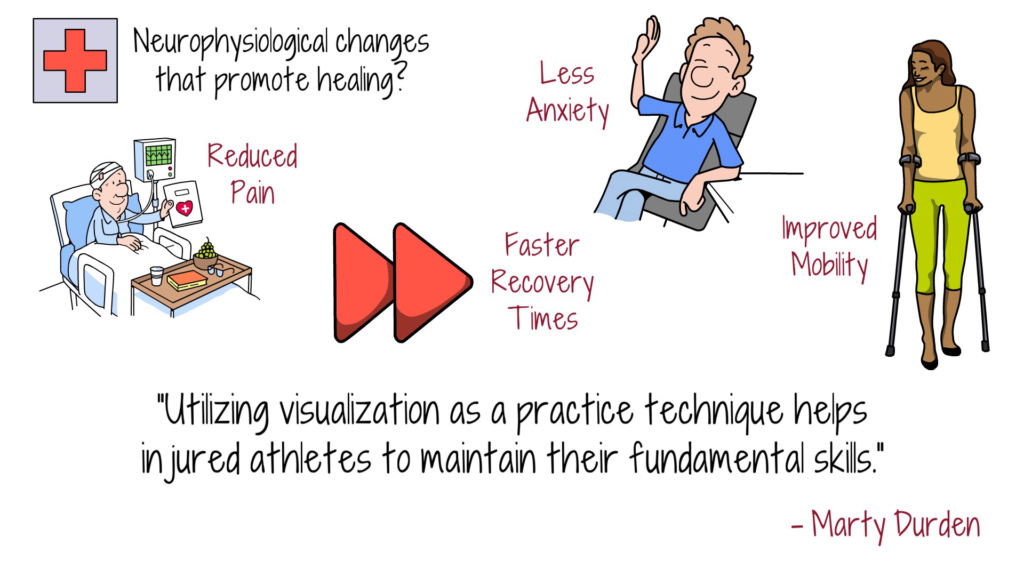
Whether you’re a recovering athlete, or you are dealing with another type of illness or injury, mental imagery may help with the healing process.
By visualizing improved health and healing imagery, many people have experienced things like:
- Less pain
- Reduced anxiety and emotional effects
- Increased movement
- Improved recovery time
Rehabilitation imagery is different from performance based visualization. It generally focuses more on relaxing and healing. However, Mental Rehearsal Visualization could still be useful for an athlete to stay focused on returning to the game. Author and Athletic Director, Marty Durden, wrote,
“Utilizing visualization as a practice technique, or rehearsal movement helps injured athletes to maintain their fundamental skills.”
In a medical setting, studies have shown that people who use Mental Rehearsal techniques to speed recovery and handle pain and emotions, can have improved healing results and better health outcomes.
In Everyday Life
Mental Rehearsal Visualization techniques can be used in any area of your life. For example, if you’re trying to improve your eating habits, take some time to sit down and visualize in detail what changes you will make. Incorporate your sense of smell, see yourself preparing the foods you want to eat, and politely declining foods you want to avoid. Imagine someone offering you cake at a party, and hear yourself saying “No, thank you.” Prepare yourself for challenges and imagine how good you feel when you choose your preferred outcome.
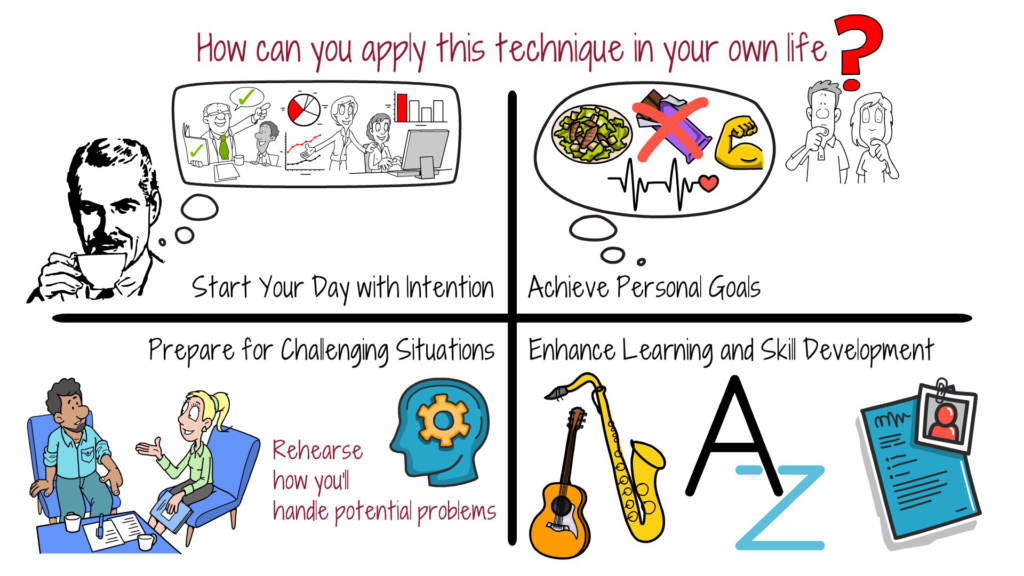
Another example is starting first thing each morning imagining how your day will go. Visualize things going well. You might picture yourself feeling good, people being courteous and helpful, the perfect parking spot is open, and having success at work. Play it all out in your mind exactly as you would like to see it unfold.
You may not be able to change things that are outside of your control, but why not do all you can to set yourself up for success? If your brain is going to be thinking about the future anyway, why not train it to expect the best possible outcome?
Another example could be when you know ahead of time that you may be encountering a difficult person, conflict or challenge. By using mental rehearsal imagery, you can plan how you will handle the situation with confidence and tolerance, leaving you feeling calm and centered. Your emotions can affect your actions, so get them in check before you encounter an actual event.
When visualizing your day, picture yourself and others as happy, healthy, and prosperous. Whether you’re taking a test, buying a car, interviewing for a job, or any other activity you have on your list, if you take the time to use Mental Rehearsal Visualization in detail before the event, you can have a better chance of a good outcome, or at the very least, a solid plan for what to do in case it doesn’t go the way you’d hoped.
Final Thoughts
When you’re focused on your goals and take time to clearly visualize them in your mind, you could be surprised by the way your brain responds.
Many successful people including world-class athletes practice Mental Rehearsal Visualization Techniques as a regular part of their training. And the reason why is because it works.
